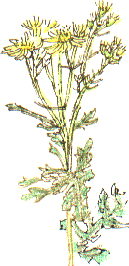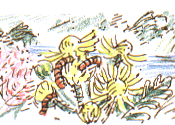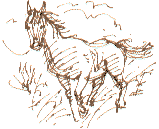 |
Poison-flowersSaturday, 12th October 2002, West Yorkshire |
![]()
![]()
![]()
![]() Rocks |
History |
Workshop |
Links |
Home Page
Rocks |
History |
Workshop |
Links |
Home Page
![]()
 After
six mainly dry weeks it is raining continuously. While writing up yesterday's
diary I sit at the desk by the studio window and sketch one of the Welsh
ponies (above) which is standing, looking rather fed up, in the
meadow. I don't realise that this will be my last chance to look out and
draw them. They are being moved to a field down the road today.
After
six mainly dry weeks it is raining continuously. While writing up yesterday's
diary I sit at the desk by the studio window and sketch one of the Welsh
ponies (above) which is standing, looking rather fed up, in the
meadow. I don't realise that this will be my last chance to look out and
draw them. They are being moved to a field down the road today.
 Common ragwort, Senecio jacobaea, is a weed of neglected pastures.
Its yellow daisy-like flowers attract hoverflies while its ragged leaves
(and the flowers) provide food for the cinnabar moth caterpillar. Like
the cinnabar moth itself all parts of the plant are poisonous. Because
of the danger to grazing stock ragwort is a notifiable weed and you can
be fined if you don't take steps to eradicate it when ordered to do so.
Common ragwort, Senecio jacobaea, is a weed of neglected pastures.
Its yellow daisy-like flowers attract hoverflies while its ragged leaves
(and the flowers) provide food for the cinnabar moth caterpillar. Like
the cinnabar moth itself all parts of the plant are poisonous. Because
of the danger to grazing stock ragwort is a notifiable weed and you can
be fined if you don't take steps to eradicate it when ordered to do so.
 Oxford ragwort, a smaller relation of common, is still in flower at roadsides
and on wasteground but the flowers of common ragwort have now died back
and its leaves are starting to shrivel. I guess that it is probably more
dangerous in this state because the ponies, browsing the last flush of
growth in the meadow, might be more likely to take a mouthful of its shrivelled
leaves. It sounds pretty awful but I've seen them munching on prickly
holly leaves, fence tops and even old Christmas trees.
Oxford ragwort, a smaller relation of common, is still in flower at roadsides
and on wasteground but the flowers of common ragwort have now died back
and its leaves are starting to shrivel. I guess that it is probably more
dangerous in this state because the ponies, browsing the last flush of
growth in the meadow, might be more likely to take a mouthful of its shrivelled
leaves. It sounds pretty awful but I've seen them munching on prickly
holly leaves, fence tops and even old Christmas trees.
 The previous Welsh pony that was kept in this meadow, Bevan, showed symptoms
of poisoning. An emergency tracheotomy in the field helped him rally,
but he died soon after. Now that ragwort is spreading again it's not worth
the risk of keeping the ponies there.
The previous Welsh pony that was kept in this meadow, Bevan, showed symptoms
of poisoning. An emergency tracheotomy in the field helped him rally,
but he died soon after. Now that ragwort is spreading again it's not worth
the risk of keeping the ponies there.
Ragwort Poisoning
14/09/2011: My thanks to Phil Patton for the following comments on the sad death of Bevan. In 2002 I recorded what I'd heard about the circumstances of Bevan's death - I wasn't actually present myself - and, in terms of Ragwort's status as a weed, what I took to be 'common knowledge' at the time. There's now a lively debate about the dangers of Ragwort poisoning to stock and to humans, but, as I've said elsewhere, I'm not qualified to make any informed comments about it.
Ragwort: a 'notifiable weed'?
"Because of the danger to grazing stock ragwort is a notifiable weed"
That's absolutely false Although the term "notifiable weed" seems to be a favourite with council websites and other offenders, it has no basis in law. It's even come up in a question in the house of commons.
There is, in fact, no such thing as a notifiable weed in England and Wales and, I'm pretty sure, the whole of the UK. I'll be happy to back that up with a longer explanation of the relevant laws and citations.
"you can be fined if you don't take steps to eradicate it when ordered to do so."Strictly speaking, this is true, but I'd question the tone, and it is incomplete. "Ordered to do so"? by whom? Not by your neighbour or the council.
It is possible that DEFRA could investigate a complaint from another land owner if it is a high risk, agree with a complainant.
Natural England can serve a notice to control the ragwort under the Injurious Weeds Act (1959). I'm trying to get stats from them of how many complaints are made, upheld and notices served.
They did immediately, and without hesitation, confirm what I already knew, though ... there is no such thing as a "notifiable" weed or plant.
"The previous Welsh pony that was kept in this meadow, Bevan, showed symptoms of poisoning."Common Ragwort poisoning? That's very sad. I say that genuinely. I believe that common ragwort poses risks to livestock when it's too close or in their feed ... especially in their feed, but the scale of the problem has been hugely exaggerated.
Was the death confirmed as common ragwort poisoning in any way? Unfortunately, the only way to determine it is a diagnosis of elimination after an autopsy. A tracheotomy seems a strange course of action if it were in response to liver damage. I'm not a vet, but it strikes me as bizarre. Perhaps it's not.
Phil Patton, 19 August 2011
I think it unlikely that there was an autopsy on Bevan. A sad end to a pony with an adventurous browsing habit, nibbling anything from Christmas trees to fence posts.
Here's another comment that I received some years ago:
Note: This correspondence is now closed. Please use your favourite search engine to follow the online debate about Ragwort and keep up with the latest medical and veterinary advice.
Link
DEFRA code of practice on how to prevent the spread of ragwort
![]()
Richard Bell,
wildlife illustrator
E-mail; 'richard@willowisland.co.uk'
![]() Next page |
Previous page |
This day last year |
This month |
Nature Diary |
Home Page
Next page |
Previous page |
This day last year |
This month |
Nature Diary |
Home Page
![]()